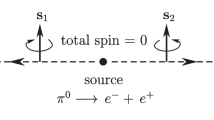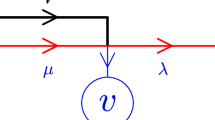Abstract
In this paper we introduce the deformed boson algebra where the even number states as well as the odd number states are deformed. Based on the set of observables associated with the quantum state, we assume that photon obeys this deformed algebra. We construct the coherent states and investigate the non-classical properties of the coherent states such as photon statistics, Mandel parameter, and quantum fluctuations of quadrature.




Similar content being viewed by others
References
E.P. Wigner, Phys. Rev. 77, 711 (1950)
L. Brink, T.H. Hansson, M.A. Vasiliev, Phys. Lett. B 286, 109 (1992)
F. Calogero, J. Math. Phys. 10, 2191–2197 (1969)
F. Calogero, J. Math. Phys. 12, 419 (1971)
M.A. Vasiliev, Int. J. Mod. Phys. A 6, 1115 (1991)
T. Brzezinski, T. Egusquiza, A.J. Macfarlane, Phys. Lett. B 311, 202 (1993)
A. Turbiner, Phys. Lett. B 320, 281 (1994)
A.P. Polychronakos, Phys. Rev. Lett. 69, 703 (1992)
A.J. Macfarlane, J. Math. Phys. 35, 1054 (1994)
V.V. Dodonov, V.I. Man\(\acute{\text{k}}\)o, Theory of Nonclassical States of Light (Taylor and Francis, Boca Raton, 2003)
R.L. de Matos, W. Vogel, Phys. Rev. A 54, 4560 (1996)
V.I. Man\(\acute{\text{ k }}\)o, G. Marmo, E.C.G. Sudarshan, F. Zaccaria, Phys. Scr. 55, 528 (1997)
D.J. Fernandez, L.M. Nieto, O. Rosas-Ortiz, J. Phys. A Math. Gen. 28, 2693 (1995)
J.O. Rosas-Ortiz, J. Phys. A Math. Gen. 29, 3281 (1996)
D.J. Fernandez, V. Hussin, O. Rosas-Ortiz, J. Phys. A Math. Gen. 40, 6491 (2007)
K. Zelaya, O. Rosas-Ortiz, Z. Blanco-Garcia, S. Cruz y Cruz, Adv. Math. Phys. 2017, 7168592 (2017)
L. Mandel, Opt. Expresss 4, 205 (1979)
Acknowledgements
The authors thank the referee for a thorough reading of our manuscript and constructive suggestions.
Author information
Authors and Affiliations
Corresponding author
Additional information
Publisher's Note
Springer Nature remains neutral with regard to jurisdictional claims in published maps and institutional affiliations.
Appendices
Appendix A
The Fock space for the deformed boson algebra is defined as
For the deformed boson algebra including the parity operator, Fock space is decomposed into two sub Fock spaces as
where
Now let us introduce the even coherent states and odd coherent states as
and
where the normalization constants are
Then, the completeness relation is given by
Thus, if we find the weighting factors \(\mu _e\) and \(\mu _o\), the completeness relation is proved. From the Eq. (76), we have
Thus, we demand
and
Using the Eq. (26), we obtain
which completes completeness relation.
Appendix B
The ordinary Poisson distribution has the probability
The mean in the Poisson distribution is
Based on the Eq. (45), the \(\nu \)-deformed Poisson distribution has the probability
In this case the mean is
Thus, \(\lambda \) is not the mean any more unless \(\nu =0\). For small \(\nu \), we have the mean
Rights and permissions
About this article
Cite this article
Chung, W.S., Hassanabadi, H. Deformed Boson Algebra with Parity Operator and Non-classical Properties of Coherent States. Few-Body Syst 62, 24 (2021). https://doi.org/10.1007/s00601-021-01609-0
Received:
Accepted:
Published:
DOI: https://doi.org/10.1007/s00601-021-01609-0




